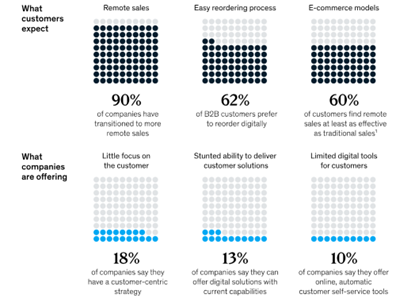B2B e-commerce has evolved across most industries at a phenomenal pace, with 65% of B2B companies now offering e-commerce solutions. These platforms have risen to keep up with the competition and deliver slick business transactions that provide lower cost to serve buyers.
For many, the temptation is to focus on how to move to these digital platforms at pace, and though there is a lot to be said for adopting quickly, more time needs to be given to selecting the right solutions for B2B ecommerce to thrive.
According to research by TrustRadius, millennials now account for 60% of B2B technology buyers. ‘Digital experiences’ is a term thrown around by many industries, but what does it mean for B2B commerce? Lots of today’s buyers are digital-first millennials with a penchant for securing and solving problems with digital tools and environments. This means more time is spent buying in digital spaces and less time talking about deals in meetings. ‘Digital experiences’ is essentially about delivering elevated commerce experiences that empower buyers and sales reps to access tools on their own terms and still get expert information when needed.
Digital commerce experiences are key
During the pandemic, 5.1 million Australian households used shopping websites monthly, a 39% increase from 2019. According to the International Trade Administration, Australia’s e-commerce market is growing rapidly and predicted to reach $32.3bn by 2024.
Although the world of commerce is growing, it is ever challenging with some industries battling the need to make technological advancements and stay relevant and innovative in digital spaces. Businesses also need to seek growth without adding cost and complexities, to consolidate technologies. This emphasises the need for simplification and a frictionless self-service model. Through a cleaner digital experience, e-commerce can be the difference in driving growth.
Digital commerce still has room for improvement
Today’s B2B organisations are having to do far more with less, as customers expect a keen focus on remote sales, easy reordering processes and E-commerce models. According to McKinsey’s studies on industrials, companies tend to be underwhelming their customers with limited offerings in the commerce space. Digital Commerce within B2B is challenging due to the complexity that businesses need to apply to their journey. There may be a hefty catalogue of SKUs to navigate through that have different priority levels and delivery requirements. Users then need more engagement and reassurance culminating in a higher need for support.
The best ways to drive growth in a commerce world….
There is a misconception amongst B2B organisations, in that they perceive their business to be too complex to sit within digital commerce spaces. But today’s technology is taking the complexity out of those set-ups and simplifying the journey. Users can now be more efficient and find the products they need quicker, giving them reassurance in their work and time back to manage other processes. Some commerce stakeholders have already wised up to this and have moved their work into digital spaces.

The consumer-led experience is one that drives the B2C journey and has influenced buyers in the B2B space that now crave that very same seamless experience. By focusing on these core elements, you can get ahead in a crowded commerce marketplace:
- Build trust and evolve partnerships
Through regular, transparent communication – invaluable relationships with vendors can be forged, meaning elements like product fulfillment and price rises are less likely to annoy buyers. By moving into a trusted advisor relationship, buyers can choose the right products and services for their needs every time.
- Drive seamless interconnected experiences
With much of our lives spent in digital spaces, the e-commerce world needs to stand out but not at the expense of all human interactions. Melding together the digital and the physical world across multiple channels is where businesses will continue to win repeat business and remains one of the trickiest challenges.
- The omni-channel world
There is a worry however that multiple channels can cause friction and fragment experiences. Conversely, going across platforms and channels is where these experiences could naturally lead to growth. For buyers, having the option of being able to visit production facilities and see products in person, as well as being able to have visibility of products on interactive commerce apps is crucial. But ensuring these experiences remain consistent, no matter which avenue is selected, is a huge hurdle to get over in delivering a connected omni-channel experience.
Experience-led growth is led by flexible and scalable platforms
To be successful, businesses need a customised commerce solution in one platform that will allow them to expand their growth and deliver an unforgettable customer buying experience.
Adobe customer HP expanded its Asia-Pacific division and turned to Adobe Commerce for a platform that could support multiple stores globally and expand their B2B commerce website. Now with the availability of best in site navigation, design templates, and on-site security, HP saw a shift of 23% of its customers shifting to online purchasing over in-store.
Commerce platforms supports end to end product and marketing lifecycles that optimise digital business outcomes from creation to conversion in six key areas:
- Content & creative – Allows users to bring together hundreds of pieces of product content to effectively sell products and services.
- Merchandising – Effectively plan and execute an intelligent merchandising, pricing and promotion strategy across channels.
- Market – Helps users target and drive awareness of key solutions to tackle complex vendor catalogs and pricing.
- Personalise – Define who your customers are and engage them in compelling experiences such as key product recommendations and easy definable product searches.
- Sell – Effectively sell your products across channels (wholesalers, vendors, dealers and retailers etc.), providing a frictionless purchasing journey.
- Understand – By learning more about key chosen products, the journey can be improved to streamline user journeys into the right areas.
Your business may be complex, but your digital commerce solution shouldn’t be. The way businesses shop has radically changed and it’s going to continue changing moving forward. Leveraging an AI-powered commerce solution that’s flexible for the future and scales to any size will be your greatest asset to deliver an unforgettable customer buying experience this year ahead.


